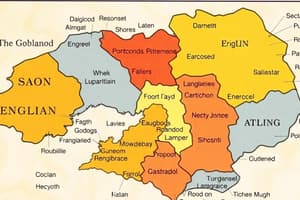Podcast
Questions and Answers
What major event influenced the development of Middle English?
What major event influenced the development of Middle English?
- The Great Vowel Shift
- Christianization of Britain
- The Norman Conquest (correct)
- Norse invasions
Old English was influenced primarily by Latin from the Christianization of Britain.
Old English was influenced primarily by Latin from the Christianization of Britain.
False (B)
Name one example of a loanword and the language it originates from.
Name one example of a loanword and the language it originates from.
ballet, French
The distinct pronunciation of American English includes spelling differences such as 'color' vs. _____ .
The distinct pronunciation of American English includes spelling differences such as 'color' vs. _____ .
Match the literary work with its corresponding period:
Match the literary work with its corresponding period:
Which of the following is NOT a linguistic feature mentioned?
Which of the following is NOT a linguistic feature mentioned?
The standard English variety is used in informal contexts.
The standard English variety is used in informal contexts.
What is the basic order of syntax in modern literature?
What is the basic order of syntax in modern literature?
The Latin alphabet consists of _______ letters.
The Latin alphabet consists of _______ letters.
Match the linguistic terms with their descriptions:
Match the linguistic terms with their descriptions:
Flashcards are hidden until you start studying
Study Notes
History of the English Language
- Origins: Developed from Germanic languages brought to Britain by Anglo-Saxon settlers around the 5th century.
- Old English (450-1150): Heavily influenced by Norse invasions and Latin from the Christianization of Britain.
- Middle English (1150-1500): Resulted from Norman Conquest; significant French influence on vocabulary and aspects of grammar.
- Early Modern English (1500-1700): Marked by the Great Vowel Shift; increased standardization and influence of the Renaissance.
Dialects and Variants
- British English: Distinct in vocabulary and pronunciation; includes regional dialects such as Cockney, Geordie, and Scouse.
- American English: Influenced by settlers from various cultures; includes distinct spelling and vocabulary (e.g., "color" vs. "colour").
- Global English: Variants such as Australian English, Indian English, and Singapore English reflect local cultures and languages.
Grammar
- Parts of Speech:
- Nouns: Names of people, places, things.
- Verbs: Actions, states, or occurrences.
- Adjectives: Describe nouns.
- Adverbs: Modify verbs, adjectives, or other adverbs.
- Pronouns: Replace nouns (e.g., he, she, it).
- Prepositions: Show relationships (e.g., in, on, at).
- Conjunctions: Connect clauses or phrases (e.g., and, but, or).
- Sentence Structure:
- Simple: Contains a subject and a verb (e.g., "She runs.").
- Compound: Two independent clauses joined by a conjunction (e.g., "She runs, and he walks.").
- Complex: Contains an independent clause and one or more dependent clauses (e.g., "Although she runs, he walks.").
Phonetics and Pronunciation
- Vowels: 12 distinct vowel sounds in British English; American English features distinct pronunciation.
- Consonants: 24 consonant sounds; variations exist regionally.
- Intonation and Stress: Intonation patterns can change meaning; stress can determine the function of a word (e.g., 'record vs. re'cord).
Vocabulary
- Loanwords: Words borrowed from other languages; examples include 'ballet' (French) and 'sushi' (Japanese).
- Neologisms: Newly coined terms (e.g., "googling," "selfie").
- Idioms and Phrasal Verbs: Expressions not deducible from the meanings of the individual words (e.g., "kick the bucket" for dying).
Literature
- Key Periods:
- Old English: "Beowulf."
- Middle English: Chaucer's "The Canterbury Tales."
- Early Modern: Shakespeare, Milton.
- Modern Literature: Emergence of diverse genres including novels, poetry, drama.
Linguistic Features
- Syntax: Generally follows a Subject-Verb-Object (SVO) order.
- Morphology: Use of affixes to create different forms of words (e.g., happy → happiness).
- Semantics: Study of meaning; includes denotative (literal) and connotative (implied) meanings.
Writing System
- Alphabet: Latin alphabet consisting of 26 letters.
- Punctuation: Essential for clarity; includes periods, commas, question marks, etc.
- Spelling: Can be irregular; influenced by etymology and pronunciation.
Language Use
- Registers: Varying levels of formality (e.g., formal, informal).
- Standard vs. Non-standard English: Standard English is used in formal contexts, while non-standard includes regional or colloquial variations.
- Code-switching: Alternating between languages or dialects depending on context and audience.
The Evolution of the English Language
- English emerged from Germanic languages brought to Britain by Anglo-Saxon settlers around the 5th century.
- Old English (450-1150) was influenced by Norse invasions and Latin from the Christianization of Britain
- Middle English (1150-1500) was heavily influenced by the Norman Conquest, incorporating significant French influence on vocabulary and grammar.
- Early Modern English (1500-1700) is defined by the Great Vowel Shift, a period of increased standardization and influence from the Renaissance.
Regional Variations
- British English: Distinct in vocabulary and pronunciation; it includes regional dialects such as Cockney, Geordie, and Scouse.
- American English: Influenced by settlers from various cultures, American English features distinct spellings and vocabulary ("color" vs. "colour").
- Global English: Variations such as Australian English, Indian English, and Singapore English reflect local cultures and languages.
Key Aspects of Grammar
-
Parts of Speech:
- Nouns: Names for people, places, and things.
- Verbs: Describe actions, states, or occurrences.
- Adjectives: Modify nouns to describe their qualities.
- Adverbs: Modify verbs, adjectives, or other adverbs to provide more information.
- Pronouns: Replace nouns to avoid repetition (e.g., he, she, it)
- Prepositions: Show relationships between words or phrases (e.g., in, on, at)
- Conjunctions: Join clauses or phrases (e.g., and, but, or)
-
Sentence Structure:
- Simple Sentence: Contains a subject and a verb (e.g., "She runs.")
- Compound Sentence: Consists of two independent clauses connected by a conjunction (e.g., "She runs, and he walks.")
- Complex Sentence: Includes one independent clause and one or more dependent clauses (e.g., "Although she runs, he walks.")
Pronunciation and Sound
- Vowels: British English has 12 distinct vowel sounds; American English has variations in pronunciation.
- Consonants: English has 24 consonant sounds, with regional variations, resulting in differing pronunciations.
- Intonation and Stress: Intonation patterns can alter meaning; stress within a word can determine its function (e.g., 'record vs. re'cord).
Vocabulary and Expression
- Loanwords: Words adopted from other languages (e.g., 'ballet' (French) and 'sushi' (Japanese)).
- Neologisms: Newly coined terms that are added to the language (e.g., "googling," "selfie").
- Idioms and Phrasal Verbs: Expressions with meanings not deducible from their individual words (e.g., "kick the bucket" for "dying").
Literature Through the Ages
- Key Periods:
- Old English: “Beowulf"
- Middle English: Chaucer's "The Canterbury Tales”
- Early Modern English: Shakespeare, Milton
- Modern Literature: Emergence of diverse genres, including novels, poetry, and drama
Linguistic Features of the English Language
- Syntax: Generally follows a Subject-Verb-Object (SVO) order for sentence structure.
- Morphology: Use of affixes to create different forms of words (e.g., happy → happiness).
- Semantics: The study of meaning, including denotative (literal) and connotative (implied) meanings.
Writing System
- Alphabet: Latin alphabet with 26 letters.
- Punctuation: Crucial for clarity, includes periods, commas, question marks, etc.
- Spelling: The spelling system can be irregular, influenced by etymology and pronunciation.
Language Use in Context
- Registers: Varying levels of formality (e.g., formal, informal)
- Standard vs. Non-standard English: Standard English is used in formal contexts, while non-standard English includes regional or colloquial variations.
- Code-switching: Alternating between languages or dialects depending on context and audience.
Studying That Suits You
Use AI to generate personalized quizzes and flashcards to suit your learning preferences.




